Shri Mahalakshmi Temple
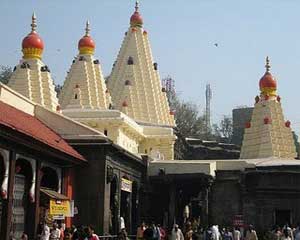
The Shri Mahalakshmi Temple of Kolhapur in Maharashtra, India, is one of the Shakti Peethas, listed in various puranas of Hinduism. According to these writings, a shakti peetha is a place associated with Shakti, the goddess of power. The Kolhapur peetha is of special religious significance, being one of the six places where it is believed one can either obtain salvation from desires or have them fulfilled. The temple takes its name from Mahalakshmi, the consort of Vishnu, and it is believed that the divine couple reside in the area.The temple belongs, architecturally, to the Kannada Chalukya empire, and may have been first built circa 700 AD. Mounted on a stone platform, the image of the four armed and crowned goddess is made of gemstone and weighs about 40 kilograms.
Bhavani mandap
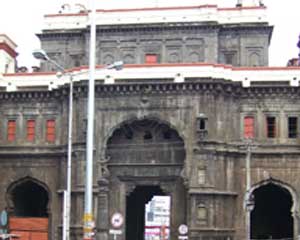
Being the biggest and the oldest building, it is the glory of the city and has historical importance. This palace was built in the reign of Shivaji Maharaj II (1785-1800 AD) when Kolhapur became a self-governed state.
It boasts of fine and sound construction which has 14 squares. In 1813 the Muslim King Sadatkhan invaded the palace and a part of it was burnt. After repairs only 7 squares have survived.
Rankala Chaupati
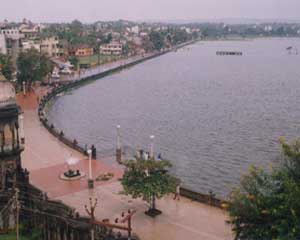
The lake is named after the God 'Rankbhairav', who is said to have been a great favourite with Mahalaxmi and to have a golden temple now hidden under the water of the lake. The beginning of the Rankala Lake is said to have been a quarry from which, according to the Jains, including the Temple of Ambabai, tones were supplied to 360 Bastics or Jain temples built by Raja Gandharaditya. Afterwards in the eighth or nineth century an earthquake is said to have enlarged the quarry and filled it with water.
Rankala Lake is a major attraction of local people & tourists. The lake rises with the morning walk of hundreds of citizens. It is a get-together venue for most of Kolhapuris. Youngsters, elders & kids, everybody loves to visit Rankala. The 800 years old lake has not only entertained people but also inspired many artists to have paintings & photographs of it.
Town Hall
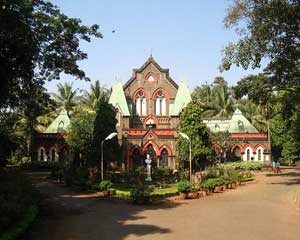
The best feature of interest in the city is the Town Hall Kolhapur Museum (Monday closed) on Bhausingji Road, 1km north of the Temple. This sober Neo-gothic structure was built as the Town Hall in 1872-76 by Charles Mant. This is his first creation in Kolhapur, the only building in pure Neo-gothic style. The frontal porch of the Museum is flanked by towers with steeply pyramidal metal roofs. Two European cannons are on display here; the example dated 1609 is engraved with a relief of the god Mars.
The Museum houses Satavahana-period items discovered in excavation at nearby Bramhapuri Hill. They include figurines of the Greek god Poseidon, riders on an elephant, and a medallion with Hellenistic figures (replica only).Pottery fragments, coins and beads from Bramhapuri are also shown.
New Palace
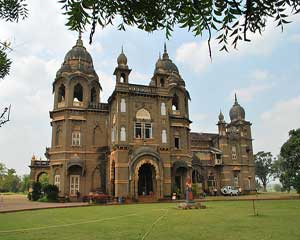
New Palace is located in Kolhapur. Built in 1884, it is also known as the Maharaja's New Place. Major Mant designed the palace. The architecture of the palace is a combination of Jain and Hindu influences from Gujarat and Rajasthan, and local Rajwada style. The first floor is for the present Maharaja, while the ground floor is dedicated to a fine collection of costumes, weapons, games, jewellery, embroidery and paraphernalia such as silver elephant saddles. A letter from the British Viceroy and Governor General of India is the other memorabilia. There is a museum called Shahaji Chhatrapati Museum at New Palace. Curious and interesting collections from the possessions of Maharaja Shahaji Chhatrapati like guns, trophies and clothes are preserved here. The museum also has large, excellent weapons collection, including a gold-plated, double-barreled shotgun, some swords, and other guns.
Shri jotiba Temple
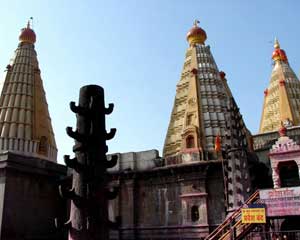
Jyotiba temple is an important Hindu religious destination located at an altitude of 3124 feet above sea level in the Panhala range of Maharashstra. It is believed that the main deity the Jyotiba is formed from the souls of three Primary Gods, Brahma, Vishnu and Shiva. Legendery stories tell that Jyotiba is formed to kill the demon Ratnasur. Visiting and offering prayers to the Incarnation of Brahma, Vishnu and Shiva as Jyotiba is a sacred ritual according to Hindu belief. Devotees and tourists throng to this temple premises for the large fair held yearly in the full moon days in the months of Vaishakh and Chaitra.
Panhala Fort
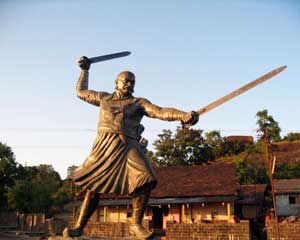
Panhala or Panhalgarh, about 19kms north-west of Kolhapur, is possibly the largest and most important fort of the Deccan. Roughly triangular in shape, the hill fort stands at a height of about 850 metres and has a circumference of approximately 7.25kms. Half of its length is protected by a natural scarp reinforced by a parapet wall and the remaining half is surrounded by a strong stone wall strengthened with bastions. The fort had three magnificent double walled gates, out of which two have survived. The Teen Darwaza to the west is an imposing and powerful structure. There are a number of ruined monuments in the fort. The most impressive among them are the three huge granaries. The largest among them, the Ganga Kothi, cover nearly 950 sq m space and 10.7 metres high. In the north-east corner there is a double story building, called Sajja Kothi, where Shivaji had imprisoned his errant son, Sambhaji.
Narsobachi Wadi
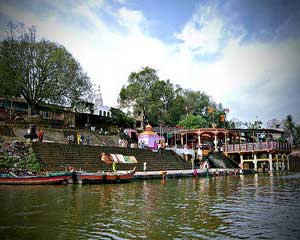
This holy place is situated on the confluence of the rivers Krishna and Panchaganga. It is well known for the holy padukas (slippers) of Dattaguru ( an incarnation of Brahma, Vishnu and Mahesh). Narasimha Saraswati, considered an incarnation of Dattaguru who lived here for 12 years. Recently, all the devotees have erected a temple called "Jahaz Mandir", which is unique in its own way, because it has been built in the shape of a ship with beautiful landscape. Narsobachiwadi is famour for Basundi, Kundhi Pedas, Kawatchi Barfi's.
Gaganbawada
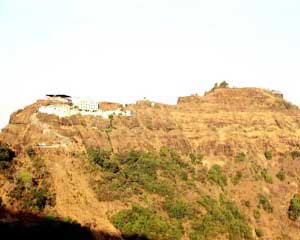
Gagangiri Maharaj was a Great Yogi. One of the few living sages having Unique Capacities, Vision and Synthesis. Gagangiri Maharaj Math is renowned as a spiritual destination for domestic and foreign travelers. The Math is located in the midst of dense forests and thick green vegetation at Dajipur nearby Kolhapur. Shri Gagangiri Maharaj was a Hindu Sanyasi (Sage) following the Nath Sampradaya. The life and history of the sage tells that Gagangiri Maharaj spent many years in this Math undergoing penance from 1932 to 1940. The Sage spent all these years in meditation in the deep jungle in this Math. This Ashram offers the Hindu teachings, yoga and meditation practices and also serves as a religious temple for the devotees. It is an attractive place for meditation, yoga and to clearly understand the Indian culture and its religious importance.
Design by Deltatech India



